Polk Audio RTi A7
Product Name: Polk Audio RTi A7
Product Description: Floorstanding Loudspeaker
-
Design - 9.2/10
9.2/10
-
Movies performance - 9/10
9/10
-
Music performance - 9/10
9/10
-
Inputs and Features - 9.2/10
9.2/10
-
Price / Quality - 9/10
9/10
Summary
Total Score
Pros
- Good quality cabinet
- Nice design
- Very good performance
- Affordable price
Cons
- Intrusive hi-end
- Need breathing space to perform good
- No magnetic grilles
Cheapest Places to Buy :
*We are a reader-supported website. When you buy through links on our site, we may earn a small affiliate commission at no extra cost to you. Home Media Entertainment does not accept money for reviews.*
For anyone that deals with audio, either it be music or home theater systems, the name Polk Audio is a familiar one and it’s a brand that has been connected with good quality for both their low cost and more higher quality speakers. In 2007 Polk Audio introduced the RTi lineup which included a complete set of speakers including 3 floorstanders, 2 bookshelf speakers, 2 center speakers and 2 surround loudspeakers. In our Polk Audio RTi A7 review today we will be looking at the second biggest floorstander in this lineup behind the top A9 model and while there are many similarities between them they also have some very distinct differences.
This lineup may be available for so many years now but being still available shows how good they really were when they first came out and are still popular to this day. The A7 specifically, tries to find a balance between the RTi A9 design that goes all out with it’s size and available hardware and a more compact design that would make it suitable for smaller spaces. The RTi lineup features many of Polk Audio’s characteristic technologies both for it’s cabinet as well as for the drivers used and really show the effort that Polk Audio put into them when in the design stage.
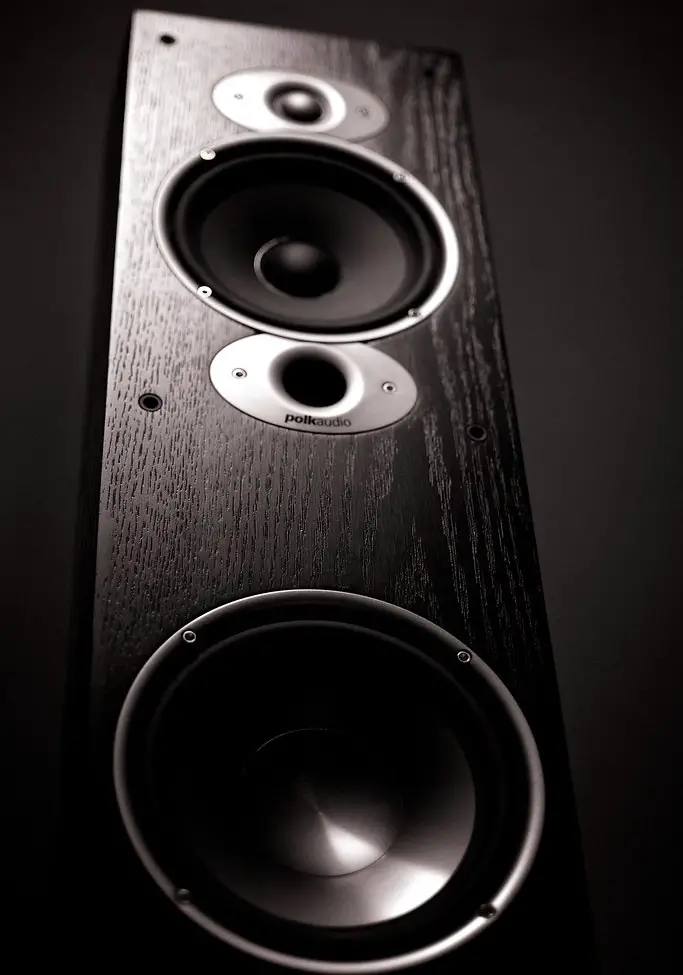
With a price that hovers around $600 each, the RTi A7 finds itself in a category that feels overcrowded at the moment as there are many good choices and excellent contenders that fight for a market share in this price range. With a price like that the A7 sits at the sweat spot between affordable for the casual masses and those that seek something a bit better than an outright casual speaker without going overboard with the price. But if Polk Audio managed to find a great balance with it’s price what remains to be seen is how the RTi A7 manages to perform and if it can make a difference in it’s respected category. Without further delay let’s find out.
Design, Inputs and Features
Exterior
The RTi A7 are no small speakers by any means. They are not the biggest we have tested but with a size of 42.25″ x 8.875″ x 17.875″ (107.32 x 22.54 x 45.4 cm) these will certainly take up some space in your room and if you take into consideration that they need certain space to work their magic then these are certainly not designed for areas that are extremely limited by space. And with a weight of 55 lbs (24.95 kg) these are definitely not light as both the good quality cabinet and internals up the weight considerably.
Polk Audio has released two color variations with Black and Cherry being the only two options. And while the Black finish looks a little bit too ordinary the Cherry one is definitely a looker and one that definitely feels like it has a character of it’s own. And if you combine the color with the intriguing design that goes away from the usual boxy look with straight lines that many speakers follow then what we get here is a speaker that decided to go outside the comfort zone. With an asymmetric design as both sides panels feature inward curves that end on the smaller back face this doesn’t only help the speakers have a rather unique design but also help them with the kind of audio they can produce.
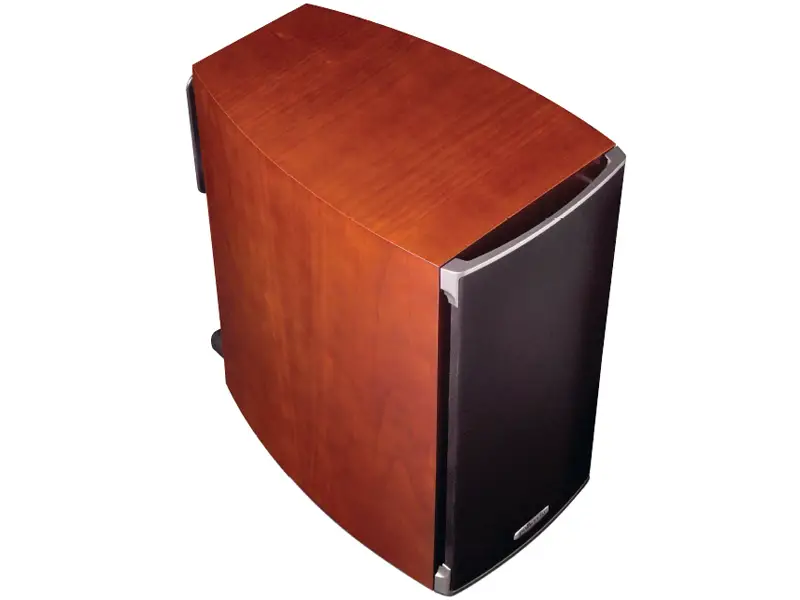
So let’s see what Polk Audio did with the cabinet in a little bit more detail. In the RTi lineup they used what they call a Damped Asymmetric Hex Laminate Isolation (DAHLI) Cabinet Design with the intent to produce more clear and accurate sound. These acoustically inert 3/4″ MDF cabinets are created using a 6-layer laminate with 5 viscous layers in order to create a damping system that was specially made for this series.
This unique design not only offers a stronger and rigid construction but the curved lines also helps with less audible coloration from panel resonances. Also it should be noted that the tweeter and mid-range driver share the same cabinet space with the rest of the design but Polk Audio has added what they call a patented ARC Acoustic Resonance Control (ARC) technology which is basically a small front port that is used for more natural mid-range reproduction.
Also the RTi A7 features PowerPort Plus that is basically two ports, one front and one rear, along with internal plates that are responsible for reducing air turbulence and increasing bass efficiency. If you add to these a computer designed tweeter faceplate radius, tapered
enclosure and baffle edge radius you get a system that was created with the intent to minimize diffraction and contribute to a more wide sound imaging. Lastly we should mention that these floorstanders are magnetically shielded so you can place them near TVs or monitors without the fear of creating any audible distortions.
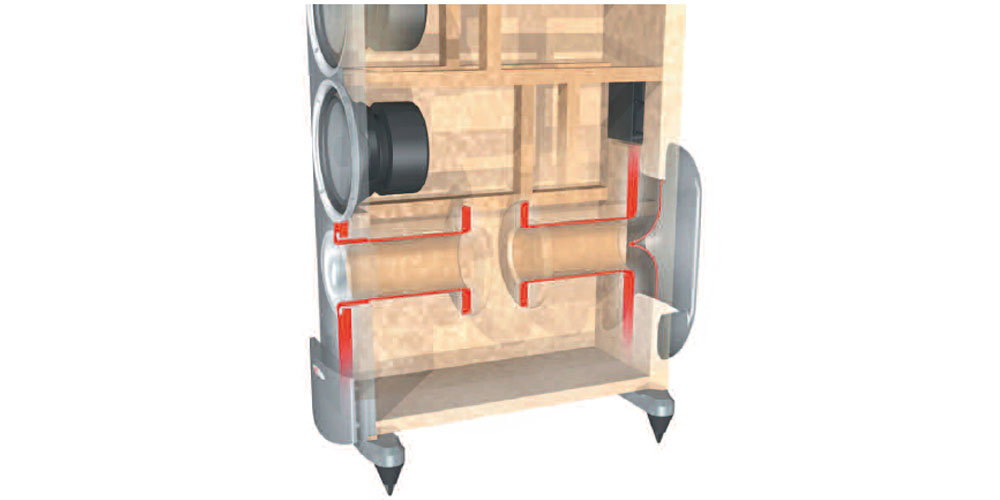
The included feet have a nice curvy design and they are very subtle looking adding to the overall nice and curvy design of the towers. The feet extend to the sides so you have to make sure you have a bit of space where you will place them as they definitely enlarge the necessary footprint of the speakers. The included feet offer excellent stability for hard floors but in case you want to place them on carpet there are spike feet that you can screw on the bottom. We really dig the design of the feet as they curvy look fit amazingly with the rest of the lines. Their side extension is not so much to become troublesome while they keep the towers very stable at all times.
The included grille frames cover the whole front baffle keeping a minimalism design when the drivers are covered. Small design touches like the top and bottom molding really make a difference as they fit perfectly with the rest of the materials while the Polk Audio logo sits at the bottom of the grilles.
Two things to note here, first of all the plastic grilles extend the front face of the speakers slightly and due to their characteristic design some may dislike them. Secondly these are not magnetic which means that if you like to use the towers without them, that we are most certain that you do, the holes where the plugs secure may look a bit ugly.

The back face, which has a smaller size due to the curvy design, features the binding posts as well as the back port underneath them that comes with a covering cone plate that we don’t usually see in speakers of this category and is responsible for streamlining the airflow out of the back which can result in better frequency response.
When it comes to the the exterior the RTi A7 masterfully combines looks with technology. The curvy lines certainly give the towers a distinct look which we really loved while technologies like DAHLI, ARC and PowerPort Plus that are implemented on this by Polk Audio shows how much work has gone into this by the engineers.
Internal Hardware
Let’s move on now to the more juicy part where we will take a look at what is inside them. The RTi A7 feature a 3-way design by incorporating a 1″ tweeter at the top with a single 6.5″ mid-range driver below it. These two use a common front port that is placed exactly below the mid-range driver and it’s meant for providing more natural mid-range performance. Under these we get two 7″ woofers with Polk Audio’s PowerPort Plus technology being placed at the bottom featuring two ports, one forward looking and one backward looking that we will talk about shortly.
The 1″ tweeter uses a dynamic balance silk polymer composite dome which ensures smoother response and improved detail while the 6.5″ mid-range as well as the two 7″ woofers use dynamic balance drivers with polymer composite cones and rubber surrounds. These drivers use a neodymium magnet as well as low-viscosity ferro-fluid cooling with a heat sink on the back of the magnet in order to offer better reliability and better power handling.
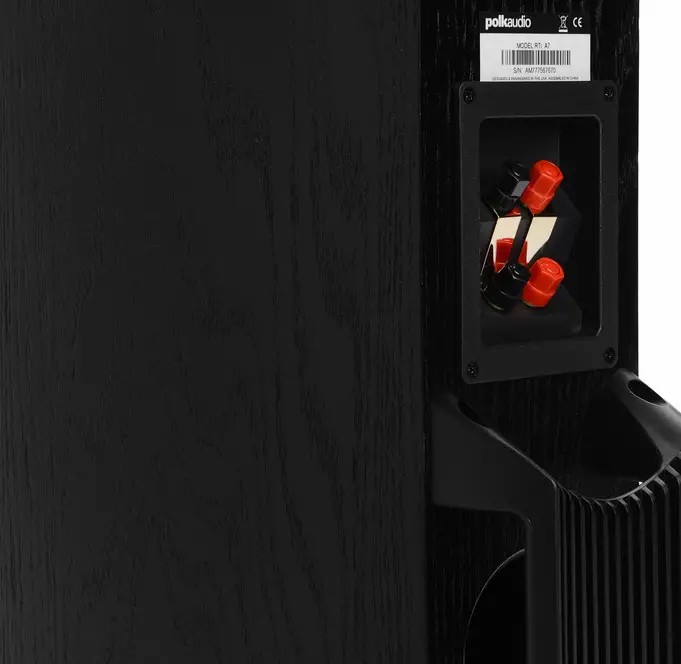
As we mentioned the A7 comes with PowerPort Plus which essentially is two ports looking at each other with one exiting the front and the other at the back. Additionally internal plates are used to reduce air turbulence and maximize bass efficiency. Lastly the included tweeter faceplate radius, tapered enclosure and baffle edge radius create the perfect conditions for wider imaging with minimal diffraction.
This 3-way system has it’s tweeter/midrange crossover frequency set at 2700 Hz while the midrange/woofer crossover is set at 125 Hz. Total frequency response is 20 Hz – 27,000 Hz with 8 Ohms of impedance and 89 db of sensitivity (1 watt @ 1 meter). The recommended amplifier power by Polk Audio is set at 20 watts – 300 watts.
Connectivity
The speakers come with high quality terminals that are placed above the rear bass port and offer bi-wire capabilities which some people like while other don’t. Each pair is positioned at a certain angle which can definitely help with wire management while gold plated connections are included if you don’t want to bi-wire them. The terminals are gold plated, 5-way binding posts which means they can accept various connections like bare wires, banana plugs or pin connectors.
Performance
With the speakers featuring a rear bass port we made sure to leave some breathing space between them and the back wall as these certainly need the room to perform good enough. We also did some toe-in to make them almost face directly to our listening position but this is something you have to try yourself and find the angle you mostly prefer. As in most of our testings we place the towers about 9 feet apart and a bit more than 2 feet from the back wall.
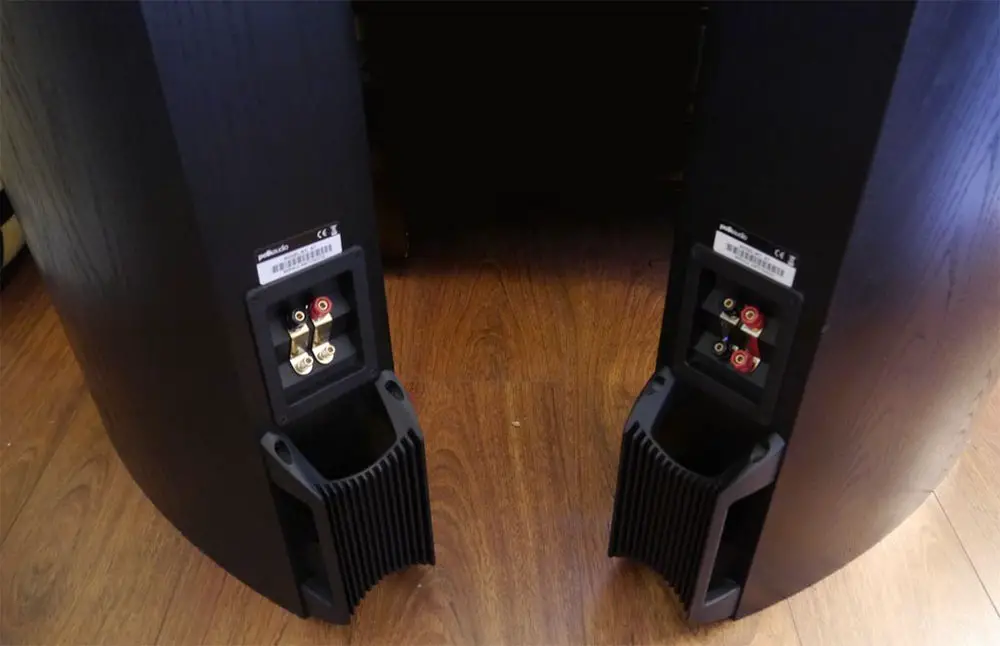
Also keep in mind that if your speakers are brand new they will need some break-in time in order to reach their peak performance. So if at first you find them not exactly to your liking this may have to do with this also. Just give them as much time as possible before you decide to return them in case you are not satisfied. The speakers we tested had already a few hours under use although we were not certain how much.
There are two setups we usually try with all floorstanders. This is usually a 4.0.2 setting without a center speaker or subwoofer in order to determine how good the front channels can cover both of these omissions while for music we tend to go for a simpler stereo setup as most music lovers prefer to do. After finishing all necessary calibrations with our Onkyo receiver we went ahead with our testing.
Movies
For testing our setup we chose to try out the 4K UHD of Midway with it’s jaw-dropping Dolby Atmos mix. This mix is a very demanding one as it has amazing surround and overhead activity while the low end is always at the forefront of the action. From the first action scenes one thing that was very obvious was how energetic the high end was. Although it was a bit more than what we would like it was not so excessive to directly call it “bright” but it was definitely more punishing than other towers we had listened to recently.
The front soundstage felt very wide and deep as the fighter planes started their dive attack on those Japanese carriers while things on the low end were very good with enough punch and weight. It was not the most accurate low end we have heard but considering the category we are in, with the A7 things felt pretty satisfactory. A subwoofer would obviously dig deeper and with more thump but it shows that the RTi A7 can also do without one and still be able to give a good shaking experience.
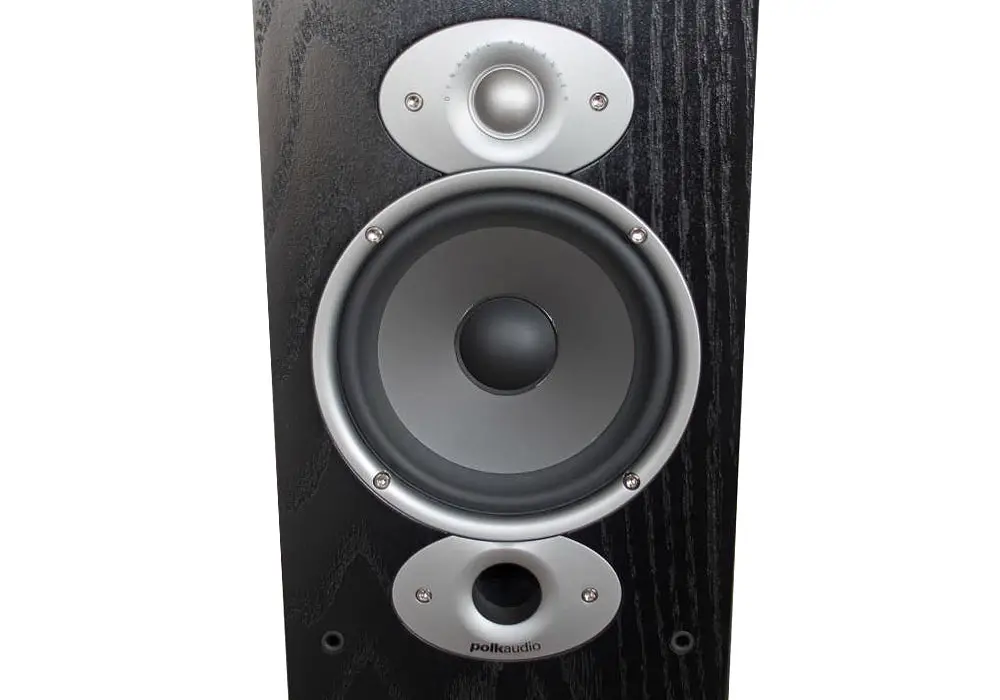
Obviously we are not here to talk much about the overhead or surround performance but we need to mention how nicely the front channels combined with the rest of the channels supplementing each other nicely. Everything felt very clear and with good overall resolution. The roaring engines of the american planes as they were being pushed to the limit to avoid the anti-air fire and explosions felt natural and with a raw texture.
Mid-range felt more balanced than the brutal high end and the front port under the mid-range driver seems to be helping with that. Precision and channel shifting between the two fronts were excellent with the A7s indicating good speed and coherence. With such hectic action the speakers never felt like lagging behind and were always to the point.
When it came to dialogue the front speakers did a really good job at covering the missing center speaker and they managed to fill the center space accordingly with dialogue as if a center channel was present. Even when the soundstage was filled with sound effects the dialogue kept it’s clarity and good separation intact from the rest of the audio which was really impressive to be honest.
Overall with a demanding track as the one in Midway you always need to get the most out of your speakers and we felt very satisfied with how the RTi A7 behaved even with a half capable setup as the one we used. We imagine that if we would go for a full 5.1.2 setup or better the towers would feel more focused but we did this as this way we can enhance their weaknesses and make them easier to distinguish. But even as such the RTi A7 are the kind of floorstanders that can really give you an unforgiving performance. If only the high end was not so intruding and we would have a real winner in this category.
Music
Moving on to our music testing we changed into a pure 2.0 stereo setup and selected a few favorite FLAC music files that we streamed through the USB port of our AV receiver.
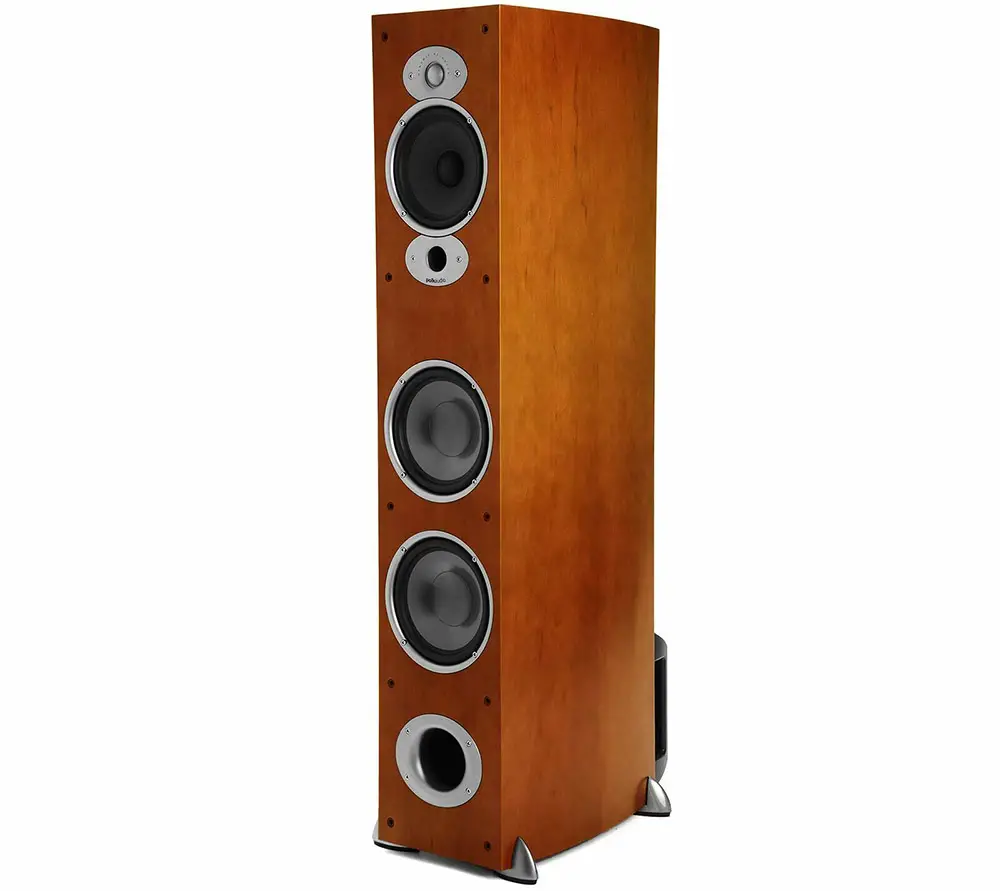
What we liked very much during this test was the impressing imaging and how spatial stereo separation was handled with finesse and accuracy. The soundstage in front of us filled with audio as the towers were very accurate in exact instrument placement. We could close our eyes and pinpoint the source of the sound showing how this was handled by the speakers with great precision.
Once again we liked how handling of the mid-range was easily the best part of this session. Smooth sound as everything came together nicely and at least with the songs we tried we never heard any breaking up. The highs were again a bit too much for our tastes but never reached ear fatigue levels although we can see many people not liking this very much. On the other end of the spectrum the speakers really did good with the bass and trying our a few bass heavy tracks showed us that they can handle it with tight control and managed not to make the sound muddy at all.
Vocals felt very focused and clear even with more demanding songs and everything came together nicely without hearing any audible distortions or major balancing issues. We also tried to push them to higher than usual levels and the towers felt like they were enjoying it. Sound came just as good without loosing any of it’s clarity or resolution.
Overall these are some very nice speakers to have for music. If you can pair them with a nice amplifier or receiver they will behave even better but for their price they are certainly an intriguing proposition. If you want a pair of speakers for your music entertainment but don’t want to spend big bucks the RTi A7 is a great choice.
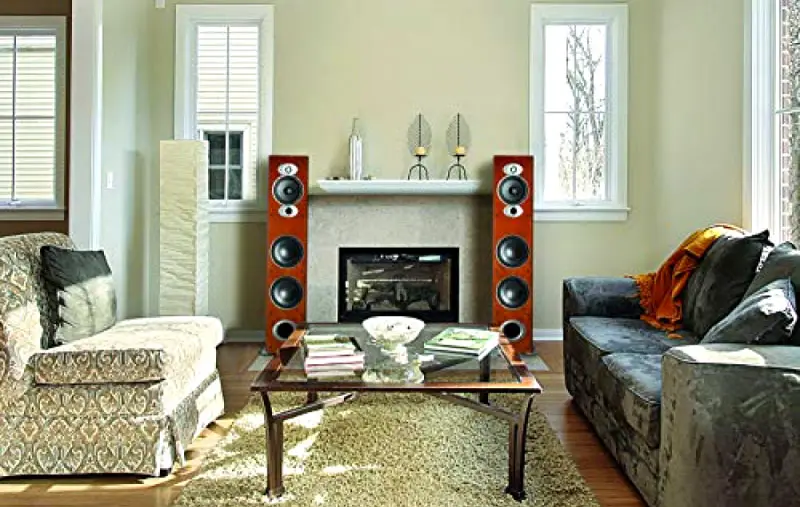
Final Thoughts
The Polk Audio RTi A7 have been in the market for many years now and their popularity show how good speakers they are even to this day. Obviously you can find better performance but for the price asked the RTi A7 is a very good offer as it can offer satisfying performance across the board and this is a result of the careful design as well as the included technologies that Polk Audio used in the series.
The towers honestly have very intriguing look that deviates from the usual and uninspiring boxy look while the quality of the cabinet is extremely good for their cost. The combination of the 1″ tweeter, 6.5″ mid-range driver and dual 7″ woofers allow the speakers to give a very dynamic and playful performance with solid mid-range and punchy low-end while treble lovers will cheer in joy.
It seems that the combination of the carefully manufactured DAHLI cabinet design, PowerPort Plus technology and the included drivers allowed Polk Audio to create a floorstander that has everything it needs for an all-around performance that is ideal and necessary for this mid-range category.
On the downsides the first thing that comes to mind is the slightly over the top high end that may be too much for some even if we never felt ear fatigue. Also the speakers gave us the impression that they need plenty of space to breathe and perform better while we would like to have magnetic grilles with such a nice design but unfortunately if you want to admire these nice drivers the baffle holes is a sight that you need to get used to.
Closing we can admit that we really enjoyed our time with these floorstanders. They may not be perfect but have enough qualities to love them and their performance, considering their cost, is totally acceptable making them an ideal mid-range offer that can be used for both home cinema or music setups. The Polk Audio RTi A7 is an excellent investment at the right cost. What more can you ask?
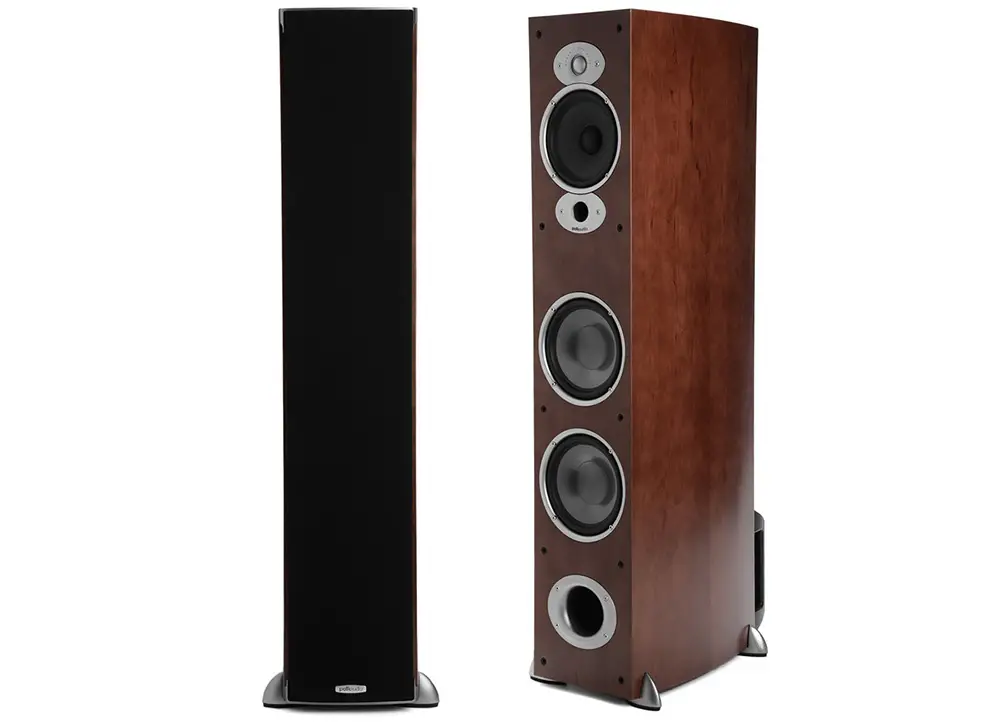
For more reviews you can check our dedicated Floorstanding Speaker reviews list or even look at our Product Reviews Table where you can find the brand and specific product you are looking for.
Cheapest Places to Buy :
*We are a reader-supported website. When you buy through links on our site, we may earn a small affiliate commission at no extra cost to you. Home Media Entertainment does not accept money for reviews.*
Thanks a lot for sharing with us this amazing review. If I want to buy a good audio system with high sound quality the Polk Audio RTi A7 seems like an interesting proposal. I like how the speakers manage to impress both visually and musically which is an amazing feat. I would like to share this post on my social media account where i have a lot of friends who are passionate in good music quality.
Please do so. The more people can see it the better.
Yes I have a pair, I love them, use them with a Cambridge audio AXR85 and Cambridge audio DacMagic 200. Great sound. On the b channel I have b&w 606 good match up.
Thanks for the comment and for your input James. Much appreciated.
I have to say that you review is one of the most thorough that I have read in some time.
Your technical depth of analysis is nothing short of comprehensive and despite the age of their design you seem to give these speakers high marks for value for money in that area. In your opinion does their technical value for money outweigh that aesthetic value enough for you top recommend these speakers to me or can I find a better balance of characteristics elsewhere?
Hamish
Hello Hamish. If these speakers are withing your budget and you like the slightly more dynamic high-end then you will definitely love them.
Phew! That is one heck of information on the RTi A7. I think you’ve covered every inch of detail on these beasts. They look wild and I can imagine the sound that they can create with those numbers of drivers and woofers.
The size seems to be on the higher side and can take quite a space, a specific dedicated music room would be ideal for them.
Overall, a must-buy for the music lovers who want to enjoy each string of sound.
They are good for both music and movies…if you like the bit edgier treble.
Hi,
I own RTi A7. Your review is spot on. The scale and agility of these speakers are very high. however, I am facing issue with high treble with my new AMP-sony str1080(which is slightly unforgiving with regards to high frequencies). My pioneer amp was not fast or fun.
I request you to kindly suggest me a speaker for smoother high frequency handling.
Want to move to Dali oberon 7. But worried that i may compromise on scale,bass and midrange.
Your help is highly appreciated.
Regards.
Hello Raman. In order to be able to give you some suggestions I need to know a few things first. You are going to use the Sony receiver with these speakers? Also what is your budget for them and also how big is the room that you plan on placing them. Let me know of these and maybe I can give you a suggestion or two.
Thank you very much for responding. My room size is 20×15 feet. My current speakers are at a distance of 17 feet from the listening position.
Regarding AVR, I changed from denon 2309 to pioneer sc-37 to Sony str 1080. I like the sony a lot.
Thanks.
I see. And what about your budget? What is your upper limit?
Thanks. around 2k$. By the way I reside in India.
Regards,
Raman
Hello Raman. Because I don’t know what brands you can find in your area if you can tell me which ones are available there I can look for a few suggestions for you.
Thank you. Please tell me your best recommendation. Will try to get them. Here, polk, klipsch,dali,focal, kefir, etc are available. But please tell me the best for my needs.
Regards,
Raman
Greetings Raman,
Ok for this kind of space and budget I can think of a couple of speakers you can check. But one thing that I strongly suggest you is that whatever you choose to buy please try to listen to them first. Because we perceive sound differently a sound that I may like may not be good enough for you. So take my suggestions just as a reference only. Your ears are the best judge when it comes to speakers selection.
Taking this out of the way the first speaker I would look at is the Polk Audio LSiM707. I have written a review about them so you can check it out. Normally these cost much higher than the budget you have but Polk runs some heavy discounts on them that come into your budget range. So look for them and who knows. Maybe you get lucky. As an alternative you can also check the Klipsch RP-8000F which come at a lower price but are also extremely good. As a third option you can also look at the Dali Opticon 8.
Hope I helped. Let me know if you need any further assistance.
Thank you very much for providing recommendations for my taste and room. I am tilted towards polk lsim 707 as it is your first recommendation.
I have a doubt. Will my sony str 1080 be able to drive them? Ofcourse I understand based on your recommendation that it will. And also, the treble will be softer.
Thanks & Regards,
Raman
The STR-DN1080 can support speakers from 6 Ohms to 16 Ohms. The Polks are rated at 8 Ohms. Also with 100 watts per channel I don’t see the reason why this receiver wouldn’t handle them.
As for the treble they should be. But as I told you the best judge is your ears so try to listen to them before buying. This is the only way to be sure that you will like them.
Thank you very much. Now I will be on the bargain hunt for polk lsim707s.
Warm Regards,
Raman
At least in Amazon and a few other retailers Polk is doing around 50% discount these days. If you are lucky and you can find them there with the same discount it should be withing your budget Raman.
I could get a pair of new Polk Audio RTi A7s for 40% off list. At basically $300/speaker can you think of any other speakers I ought to consider? I had been leaning towards Polk S 60s but I can’t get them at a price I can afford. I’m not a huge fan of overly bright speakers (over-emphasized treble). I have a fairly large room…15′ wide by 25′ deep with a normal height ceiling.
If you are not very fond of over-emphasized high end then you may find the RTi A7s a bit too much for your liking. But obviously only if you try them yourself you can be sure of that.
As for other options if you let me know your max budget I may be able to give you some alternatives.
Stratos…..I am sort of limited to $600-700 for a pair of floorstanding speakers. I have a pair of Definitive Technology Pro 400s that I have had for 20 plus years. They have been okay but I’d like a change. I recently did a remote, on-line listening kit test on Crutchfield with a pair of their headphones and the speakers I liked the best (that were higher than I wanted to spend) were the Polk S60s and the SVS Prime Towers. I’m just wondering from your perspective what other options I should consider.
Well, at the price limit you have there are not many good options to consider. I have a few models in mind but they go higher at around $1,000 per pair so this won’t do. I think the only way to get a good pair of speakers in this price is with some sort of discount as you found the RTi A7 so these are your best bet at the moment for this given price.
So hypothetically…what might you suggest at the $1,000-ish point. I ask because sometimes speakers do get heavily discounted for sale. Thanks again for your input and patience.
Hey Tony. If I had a $1,000 limit then there are a few more options out there. One of my suggestions for you would be the Q Acoustics 3050i while as an alternative I would also suggest the ELAC Uni-Fi UF5. The Dali Zensor 5 is also withing this price range but considering your room size the Zensor 5 may be a bit small and I think the Zensor 7 goes beyond that price limit.
Thanks for the ideas.
No problem. Let me know if i can do anything else for you.
Stratos…..You’re gonna grow real tired of me and my question! I just noticed the Polk website has the Polk RTi A9s on sale for $449/speaker. Good price but are they any less bright than the RTi A7s ? Getting back to an earlier suggestion you made I found a stereo store not too far away that would give me an opportunity to audition the Elacs you mentioned and Paradigm Monitor SE 6000f which I have also heard good things about.
Hello Tony. You can write me as much as you want, I never get tired of answering questions and helping people as much as I can.
First for the A9s unfortunately I haven’t tested them so I cannot tell you if they are less bright than the A7. So this is a bit of a gamble but the price is indeed interesting.
As for the Paradigms they are also great speakers. I am really curious to see if you like the ELACs or the Paradigms more. Let me know once you test them.
Stratos,
…from a RTi A series owner*, specifically the ‘A7s since 2008. I’m very sorry for my long-winded reply. I wrote mostly for the benefit of others reading this.
* CSI A6 center & RTi A3s for surrounds
For the record: the entire RTi/RTi A series and their center speakers, use the same tweeter. Further, while each model is XO’d a bit differently from others, all have the same top end characteristics that softens a bit over time, but never completely goes away.
The RTi/**RTi A**/CSi A series tweeter is fussy about electronics. It likes a very clean upper end. It’s best in rooms w/carpeting and/or large area rugs, heavy drapery, & cloth upholstered furniture. Polk contoured these speakers for Home Theatre** but they can truly be startlingly for some but, as you learned, not all music programming.
** RT/RTi/RTi A = Reference Theater/Reference Theatre improved/Reference Theatre improved Advanced
I know that you, Stratos, know. But for the benefit of those that don’t know, even w/the right electronics, put any of these speakers in very to highly reflective rooms, (uncovered hardwood or tile flooring and/or lots of uncovered glass on one or both sides) WILL make for an unhappy buyer.
Another key point: the A7s & especially the A9s like power. Sufficient power will bring out their musically great, tight, extended low ends.
Most AV receivers’ specs suggest they can, but they can’t. A search on the Polk forum will net MANY threads of people that, when they added a power amp that delivered quality, true 100+WPC*** or did a significant AVR upgrade, they were, then at least satisfied though most were thrilled, w/ the results.
*** more of the same is better still
Some of the last paragraph comes mostly from reading many of those many Polk Forum threads of ultimately happy ‘A7/9 owners. Also from having several systems in quite a few different environments, and 41 years in this hobby. I’ve always used separate power amps in my home theatre. That includes dedicated amps for the center and surrounds. Been through several makes* along the way. What works* for me, probably won’t work for them. “Their mileage will vary.”
Thanks for reading this far. Hope it helps someone. Tony
Thank you very much Tony for sharing your thoughts on the RTi A speakers. The reality is that in most cases separates is the way to go. I think no person can deny that. It’s just that many times, for various reasons, this is not possible. An AV receiver will never have the power and quality that separates can have. But on the other hand an AV receiver offers the practicality of having everything in one. Is it the best? Of course no, but we don’t all have big rooms with plenty of space to place separates or the budget more often than not is limited to go that route. I think what you mention about the Polks relate to many speakers in this market, it’s just that some speakers may be more demanding than others and going for separates would indeed be preferable.
As for their sound I always suggest to people again and again that all my observations regarding how speakers sound are how I perceive sound. Because I find a speaker good/bad doesn’t mean you will hear the same. As we all are biological receivers (our ears) each person understands sound differently. That’s the reason I always suggest to people that ask me to suggest them speakers to go listen to them by themselves. I can give a general idea through my reviews but when it comes to sound and specifically speakers each ones ears should be the best and only judge.
Just received my my A7s last night. first impression was AWESOME. I’ve had a lot of speakers in the past that were great. These were AWESOME. Clear, deep, low end, well produced mid range and high freq. I’m a wood worker so I hate veneer but compromise with speakers because being an engineer the mdf actually is better for speakers. Sad. but the finish on these is great. My house is an oak overload that would make most interior decorators puke. But like I said I love wood. They fill our living room which is 24 x 24 easily on very low volume. On a short stint with tv as a source I heard things I never heard before. The tv show SWAT actually has dramatic music very low in the show. I’ve never heard. I actually was looking at my vintage components and wandering If I was hearing bleed through from the tuner. Admittedly we usually don’t play tv through the stereo but I had no Idea how bad the tv speakers were. IF you’ve never heard these go listen. Just buy a set if their at the top of your budget. You won’t regret it. I also have a two sets of polks old huge book shelfs I can’t think of the model, But they rock my office. I might just be buying two more at7 s to replace.
Hey Kevin. I am glad you liked the A7s so much. They are indeed very nice speakers for their price.
I have present set-up of Yamaha RXV583 AVR with Jamo S406 . But I am interested in buying Polk Audio RTi A7 will it be compatible with my AVR , some people are saying it may blow my AVR please help me out.
Hey there. Well, blowing your receiver may be a bit too much. The RX-V583 receiver supports 8 ohms speakers and has a power output of 80W (20Hz-20kHz, 2ch driven).
The RTi A7 are 8 ohms speakers and have a recommended power per channel of 20 watts-300 watts. So the Yamaha may be at the very low end and you may not get the best out of them but claiming that these will blow your receiver cannot be backed up by the specs I see.
But to be honest if it was me and I would consider getting such speakers I would definitely plan on getting a new AV receiver also that would make them real justice and just to be on the safe side.
Hello….. I,ve denon 550 bt,can it handle rti A7, if not whet avr should I buy..
Hey there. In theory it should be ok but it is definitely on the low side and I would suggest you to get something better. Now for suggestions it depends on your budget as there is a huge number of models that you can choose from.
Thanks for reply.. ..
Actually my room size is 25×12×12, I want to buy a 7.2 channel avr which can handle rti A7…… Is denon avr x 2600 h ok… ? or should I got for higher models
The Denon AVR-X2600H should be fine to drive these speakers and is far better than the 550 you have now. If you could go for the 3600 even better but the 2600 should do ok if you cannot go higher.
Hello Steve…. I just purchased these and can’t wait to hear them. Not being able to personally audition speakers in store, your reviews were invaluable to my decision .
Thank you for all the great information.
Regards,
Craig
Hey Craig. I am glad our reviews helped you make up your mind and I hope you will like the speakers you bought. Although it is a risky move to buy speakers without audition because we perceive sound differently and something that I find good may not apply to you. Fingers crossed you will find them as good as I did.
Oh and my name is not Steve…it’s Stratos but it’s ok. Many make this mistake 😉
Hi Stratos
Very impressed with your knowledge and availability to answer everybody’s questions. Now, I have been using RTi7 for the last 4-5 years and I am happy with my Yamaha VRX777 receiver. I use a Sonos Connect into the receiver to stream music from Spotify and I have a BK 300W subwoofer (fed from the sub out of the receiver), basically a likable 2.1 system. As everybody else, I am looking for way to improve the sound quality of my system, so I have purchased some replacements: instead of the Sonos will use a Cambridge Audio CXN v2 streamer and instead of the receiver (2x100W / 8ohms) got a 20 years old Musical Fidelity A308CR power amp (2x250W/8ohms). To make it more interesting, I bought a Schiit Saga preamp as well to put it between the streamer and the power amp.
Due to the present lockdown, can not travel to my holiday home (where I have this system) to install my new “toys”. My question: should I expect an improvement or just waisted my cash? Any suggestions welcome.
Hey Minica. Nice setup you have made there. Unfortunately I cannot give you a direct answer. In theory the parts you have purchased are obviously far superior to the Yamaha AV receiver but with so many parts it is difficult to say if this specific combination of all of them will give you a meaningful improvement. Because it does not only depend how much better equipment you get, it also depends on how you perceive sound and if your ears will understand the difference.
So to keep things simple. Is the setup you made better than before? Yes it is, by far. Will you understand the improvement? Probably, but my answer above cannot allow me to give you a very clear answer on that.
Hello Stratos! Would the Polk RTi a7’s be compatible with a vintage amplifier? You see I have acquired an early 1970s Marantz 4300 quadradial amp and it’s a monster! It’s rated 100 watts per channel in the stereo setting and I’m worried that it might blow the poor polks up?! Both of these were gifts so I would be pleased as punch if they were forever compatible! Me and my record collection thank you for you insight and I wish you pleasant evening.
Hello Joel. I don’t have first hand experience from this amplifier but why wouldn’t it be good for the Polks? The RTi A7s have a recommended amplifier power rating of 20 watts – 300 watts which is very well within what the Marantz can do (100W/ch in stereo).
Hi Stratos,
I appreciate how humble you are to respond every bit of the questions by everyone.
I’m using RTI A7s from couple of years for stereo only, like them very much, so far the best the played with my Akai AA1200 receiver, but unfortunately I sold that to a professor, later I played them with different amps but only stopped at Marantz PM80, it drives them good too;
Tried them with Arcam power amp too but could not differentiate the performance, IMO Marantz does better
The real question comes in my mind is that if I do bi-amping or bi-wiring, will that make any difference?
Hello Shahid and thank you for your comment. Concerning bi-wiring and bi-amping without going into very much details what I can say is that with be-wiring these speakers most probably you will not hear any difference at all. Now bi-amping them is a different matter as it depends greatly on the combination of amps used and the speakers at hand. There may be some small difference or there may not be at all. This unfortunately I cannot tell you as the combinations are infinite. But to be honest if there is some difference it would be too small to be worthwhile. Unless you don’t care about the cost of getting two amps so then go for it.
To tell u the truth… hooked them up in 2013 to Pioneer 5.1 System… without Bi Amping (as it is quite old) but didn’t like the sound at all… tried it without my hearing aid too…. bought them when they were real expensive….still like my 2 way Pioneer 1975 Speakers and it’s matching Stereo Receiver….
Next project….will hook up my 1975 Pioneer Receiver to them and see what it sounds like…
Hey Elvis. Thank you for your input, it seems you have a lot going on there. Let us know how it went with your next project!
Hi,
Excellent review.
I want to use Pioneer SX-535 Stereo Receiver with Continuous power (at distortion):
8 Ohm: 2x 20 W (RMS, 20 – 20’OOO Hz).
4 Ohm: 2x 22 W.
Will they perform properly and not overheat the Stereo Receiver as the Recommended Power per Channel is 20 to 300W? I had asked something similar before as well. Cheers from Canada.
Hey there. I wouldn’t recommend it since it seems that the Pioneer is at the lower end of what these speakers need. Obviously I cannot be absolute certain that you will have problems but you will be taking a risk trying it.
I’ve had the Polk RTi A7s for 8yrs or so. Couldn’t be happier. Running on my early 90s Yamaha receiver, the sound is amazing. Maybe it’s just me, but I don’t get all this talk of “excessive highs”. Have played all kinds of music through them and never thought the high end was fatiguing or excessively sharp. Perhaps one’s sharp is another’s crystal clear. or maybe these components just play well together. It is time to upgrade to a new integrated amp.. and i’ll be sticking with one of the newer Yamahas.
Hey Ken. Thank you for sharing your experience with the RTi A7. Really appreciate it. Your comment really shows that when it comes to sound things are not so clear cut. As every person perceives sound differently. That’s why when it comes to speakers we always highly recommend our readers to try them out for themselves. Because no matter what we write in our reviews, our opinion may not reflect to every single person out there.